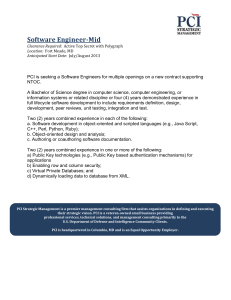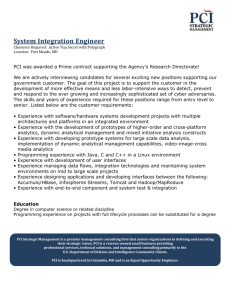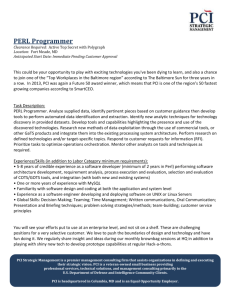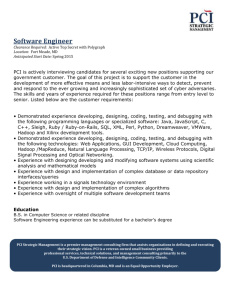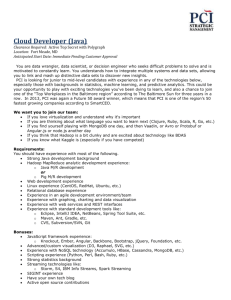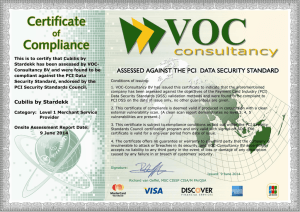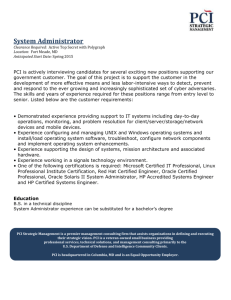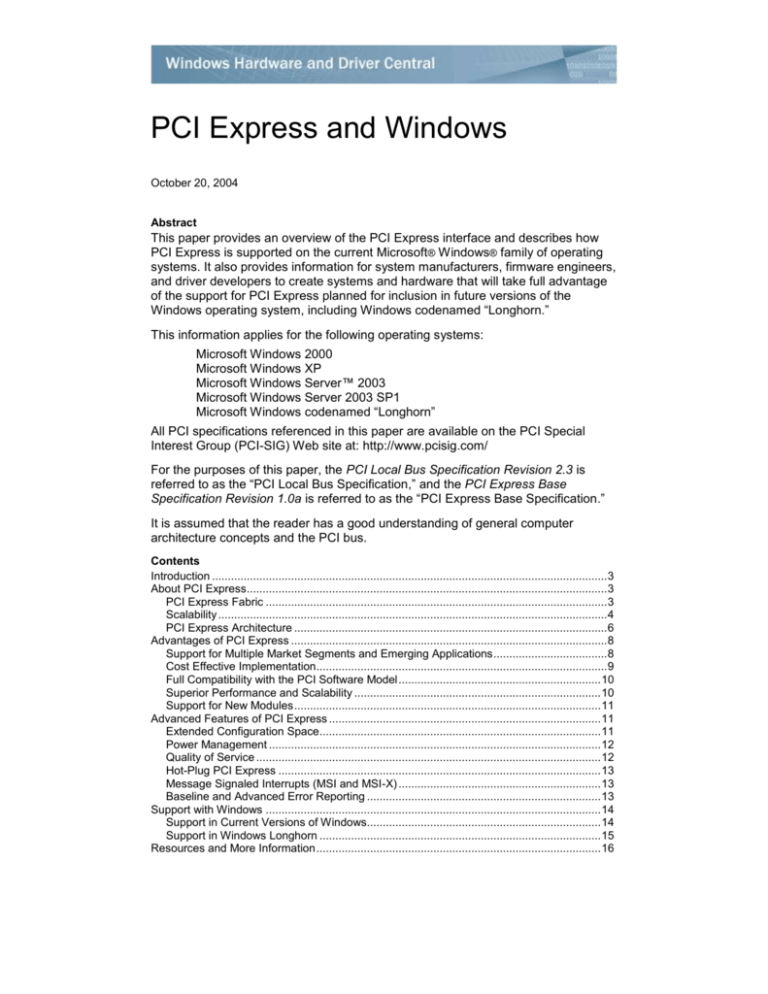
PCI Express and Windows
October 20, 2004
Abstract
This paper provides an overview of the PCI Express interface and describes how
PCI Express is supported on the current Microsoft® Windows® family of operating
systems. It also provides information for system manufacturers, firmware engineers,
and driver developers to create systems and hardware that will take full advantage
of the support for PCI Express planned for inclusion in future versions of the
Windows operating system, including Windows codenamed “Longhorn.”
This information applies for the following operating systems:
Microsoft Windows 2000
Microsoft Windows XP
Microsoft Windows Server™ 2003
Microsoft Windows Server 2003 SP1
Microsoft Windows codenamed “Longhorn”
All PCI specifications referenced in this paper are available on the PCI Special
Interest Group (PCI-SIG) Web site at: http://www.pcisig.com/
For the purposes of this paper, the PCI Local Bus Specification Revision 2.3 is
referred to as the “PCI Local Bus Specification,” and the PCI Express Base
Specification Revision 1.0a is referred to as the “PCI Express Base Specification.”
It is assumed that the reader has a good understanding of general computer
architecture concepts and the PCI bus.
Contents
Introduction ............................................................................................................................. 3
About PCI Express .................................................................................................................. 3
PCI Express Fabric ............................................................................................................ 3
Scalability ........................................................................................................................... 4
PCI Express Architecture ................................................................................................... 6
Advantages of PCI Express .................................................................................................... 8
Support for Multiple Market Segments and Emerging Applications .................................... 8
Cost Effective Implementation ............................................................................................ 9
Full Compatibility with the PCI Software Model ................................................................ 10
Superior Performance and Scalability .............................................................................. 10
Support for New Modules ................................................................................................. 11
Advanced Features of PCI Express ...................................................................................... 11
Extended Configuration Space ......................................................................................... 11
Power Management ......................................................................................................... 12
Quality of Service ............................................................................................................. 12
Hot-Plug PCI Express ...................................................................................................... 13
Message Signaled Interrupts (MSI and MSI-X) ................................................................ 13
Baseline and Advanced Error Reporting .......................................................................... 13
Support with Windows .......................................................................................................... 14
Support in Current Versions of Windows.......................................................................... 14
Support in Windows Longhorn ......................................................................................... 15
Resources and More Information .......................................................................................... 16
PCI Express and Windows - 2
The information contained in this document represents the current view of Microsoft Corporation on the
issues discussed as of the date of publication. Because Microsoft must respond to changing market
conditions, it should not be interpreted to be a commitment on the part of Microsoft, and Microsoft cannot
guarantee the accuracy of any information presented after the date of publication.
This White Paper is for informational purposes only. MICROSOFT MAKES NO WARRANTIES,
EXPRESS, IMPLIED OR STATUTORY, AS TO THE INFORMATION IN THIS DOCUMENT.
Complying with all applicable copyright laws is the responsibility of the user. Without limiting the rights
under copyright, no part of this document may be reproduced, stored in or introduced into a retrieval
system, or transmitted in any form or by any means (electronic, mechanical, photocopying, recording, or
otherwise), or for any purpose, without the express written permission of Microsoft Corporation.
Microsoft may have patents, patent applications, trademarks, copyrights, or other intellectual property
rights covering subject matter in this document. Except as expressly provided in any written license
agreement from Microsoft, the furnishing of this document does not give you any license to these
patents, trademarks, copyrights, or other intellectual property.
Unless otherwise noted, the example companies, organizations, products, domain names, e-mail
addresses, logos, people, places and events depicted herein are fictitious, and no association with any
real company, organization, product, domain name, email address, logo, person, place or event is
intended or should be inferred.
© 2004 Microsoft Corporation. All rights reserved.
Microsoft, Windows, and Windows NT are either registered trademarks or trademarks of Microsoft
Corporation in the United States and/or other countries.
The names of actual companies and products mentioned herein may be the trademarks of their
respective owners.
October 20, 2004
PCI Express and Windows - 3
Introduction
The PCI bus has served the industry well for the past 10 years. During this time,
numerous new technologies that place new feature and bandwidth requirements on
this I/O bus have been developed. As an aging technology, PCI can no longer
handle the demands of the new classes of I/O devices, such as High Definition
Audio and Video, Gigabit Ethernet, and next generation storage controllers and
devices. Although engineers have performed admirably to extend the usefulness of
PCI through their work on the PCI-X bus, it is clearly the right time to introduce a
new I/O bus that is more scalable and addresses the demands of next generation
hardware and software.
The PCI-SIG has defined a new I/O technology, PCI Express, which over time is
expected to replace the current I/O bus technologies PCI, PCI-X, AGP, and
CardBus. PCI Express addresses many of the shortcomings of the current I/O bus
technologies and provides advanced features that exceed the capabilities of the
older technologies.
PCI Express is not a parallel bus like PCI and PCI-X, but rather is a serial interface
consisting of individual Links that are shared by only two devices. This serial design
has many advantages over the parallel bus design and provides advanced features
not offered by PCI or PCI-X.
PCI Express retains full software compatibility with the PCI Local Bus Specification
Revision 2.3. PCs which have implemented PCI Express can boot and run current
Windows operating systems (Windows 2000, Windows XP, and Windows Server
2003) without requiring modifications to the operating system or the device drivers.
System manufacturers can take advantage of the higher bandwidth of PCI Express
immediately. Firmware engineers can update the ACPI firmware to make some of
the advanced features of PCI Express available to the current Windows operating
systems. Once available, Windows Longhorn will natively support the advanced
features of PCI Express for a deeper, richer user experience.
About PCI Express
PCI Express is a quantum leap in technology over the PCI bus, providing greater
bandwidth and an architecture that can be scaled to meet the requirements of next
generation hardware and software. This section provides information about the
fabric, scalability, and architecture of PCI Express.
PCI Express Fabric
The fundamental building blocks that make up the fabric of the PCI Express
interface are Lanes and Links.
Lane. Each Lane represents a dual-unidirectional communications channel
between two PCI Express devices. A Lane consists of two pairs of traces
that carry low voltage (0.08 to 1.2 volt) signals. Each signal pair carries 2.5
gigabits/second of traffic in one direction, as indicated by the arrows in
Figure 1. One signaling pair is used by a device for transmitting data and
one pair is used for receiving data. Because Lanes connect only two
devices, the signaling pair used by Device A to transmit data is the same
pair used by Device B to receive data.
Link. Two PCI Express devices are connected by a Link, and each Link is
made up of one or more Lanes. PCI Express supports the following Link
widths: x1, x2, x4, x8, x12, x16, and x32 Lanes. Figure 1 shows a x1 Link.
October 20, 2004
PCI Express and Windows - 4
Figure 1 – A x1 Link uses a single Lane to connect 2 devices (A and B) together.
One advantage of the serial architecture of PCI Express is the lower pin count for all
PCI Express devices compared to PCI and PCI-X. For example, a x1 Link uses only
eight traces (four for data and four for other uses such as power and ground)—
significantly fewer than a PCI bus, which uses a minimum of 74 traces. This more
pin-efficient design not only reduces manufacturing costs, it also greatly reduces the
number of traces that are required on the printed circuit board (PCB), thus
simplifying the routing of traces. Additionally, this architecture reduces the electrical
issues that limit the signaling rate of PCI and PCI-X.
Scalability
Another advantage of PCI Express over PCI and PCI-X is the amount of bandwidth
the former can support while using significantly fewer pins and traces. The PCI
Express Specification defines the initial signaling rate for PCI Express as 2.5
gigahertz. This means that each Lane can carry 2.5 gigabits of data simultaneously
in each direction using only eight traces.
PCI Express uses 8-bit/10-bit encoding, which means that an extra two bits are
added to each byte to embed the clock signal in the data stream. This means that a
byte in PCI Express is equal to 10 bits. The bandwidth of a single PCI Express Lane
is calculated as follows:
2.5 gigabits/second divided by 10 bits per byte
= 250 megabytes x 2 (each direction on the Link)
= 500 megabytes/second total bandwidth per Lane.
It is interesting to compare the bandwidth of a PCI Express Lane to the bandwidth
of the PCI and PCI-X buses. The bandwidth of a PCI or PCI-X bus is calculated as
follows:
(Signaling rate in megahertz x width of the bus in bits) / 8 bits per byte
= maximum throughput of bus in megabytes per second.
For PCI and PCI-X, the PCI-SIG has defined signaling rates from 33 MHz to 266
MHz and is working on a specification for a 533 MHz signaling rate. PCI operates at
signaling rates of either 33 MHz or 66 MHz, and PCI-X operates at 66 MHz and
higher. Both PCI and PCI-X buses support 32- and 64-bit bus widths; however,
because of the engineering issues and amount of space required to run the traces
for a 64 bit-wide bus, it is used only in the server market segment.
The following table shows the total bandwidth that can be achieved by different PCI
and PCI-X bus configurations.
October 20, 2004
PCI Express and Windows - 5
Table 1 – Total bandwidth for PCI and PCI-X
Signaling rate
Bus width
Bus type
(in MHz)
(in bits)
33
32
PCI
33
64
PCI-X
66
32
PCI and PCI-X
66
64
PCI-X
133
64
PCI-X
266
64
PCI-X
533
64
PCI-X
Total bandwidth
(in megabytes/second)
132
264
264
528
1064
2128
4264
You may notice that the bandwidth for a 64-bit wide PCI-X bus running at 66 MHz is
higher than a single PCI Express Lane running at 2.5 gigahertz. However, PCI
Express can be scaled to meet higher bandwidth requirements by increasing the
number of Lanes between the devices.
To further increase the bandwidth of a Link, multiple Lanes can be placed in parallel
between two PCI Express devices to aggregate the bandwidth of each individual
Lane. As mentioned earlier, Lanes can be added between PCI Express devices in
the following increments: x1, x2, x4, x8, x12, x16, or x32.
For example, a typical design for a high-performance desktop PC is expected to
implement the following PCI Express Links:
x16 Link for graphics and other multimedia devices
x8 Link for high performance chip-to-chip interconnect, network and storage
devices
x4 Link for general chip-to-chip interconnect, network and storage devices
x1 Link for general I/O
The following table shows the bandwidth of a PCI Express Link for different Lane
widths.
Table 2 – Increasing Bandwidth by Adding Lanes
Number of Lanes
per Link
Bandwidth (in megabytes/second) in each direction
1
2
4
8
12
16
32
250
500
1,000 (approximately1 gigabyte)
2,000 (approximately 2 gigabytes)
3,000 (approximately 3 gigabytes)
4,000 (approximately 4 gigabytes)
8,000 (approximately 8 gigabytes)
The device that currently uses the most bandwidth on today’s PC is the graphics
adapter on the 8X AGP bus, which can transfer data at approximately 2
gigabytes/second. When you compare the bandwidth of an x32 PCI Express Link to
the bandwidth of an 8X AGP bus, you can see that PCI Express can support the I/O
requirements of PCs well into the future.
In addition to adding Lanes to scale the bandwidth, the PCI Express interface is
designed so that the signaling rate can also be increased. The PCI-SIG working
group is currently working on defining two additional signaling rates, which are
expected to be 5 and 10 gigahertz. Once these additional signaling rates are
defined, PCI Express system manufacturers will be able to scale the bandwidth of
October 20, 2004
PCI Express and Windows - 6
PCI Express Links using any combination of signaling rate and Link width on a
device-by-device basis. These new signaling rates will enable system
manufacturers to achieve two to four times the currently defined bandwidth.
PCI Express Architecture
PCI Express is defined in a flexible way that enables system manufacturers to
benefit immediately from its scalability while their systems remain backward
compatible to PCI and PCI-X. Additionally, PCI Express leverages the form factors
and manufacturing processes already used in today’s PCs.
The PCI Express architecture consists of the following devices:
Root Complex: The heart of the PCI Express interface is the Root
Complex, which is made up of one or more Host Bridges. Each Host Bridge
exposes one or more Root Ports, which appear as PCI-to-PCI Bridges to
software and can be used to connect other PCI Express devices, such as
Endpoints or Switches, to the Root Complex. System CPU(s) and system
memory are also connected to the Root Complex, usually through a system
bus.
PCI Express Slots: Physical connectors that allow PCI Express adapters
to connect to the PCI Express fabric.
PCI Express-to-PCI Bridge: A PCI Express device used to connect PCI
devices to the PCI Express fabric.
PCI Express-to-PCI-X Bridge: A PCI Express device used to connect PCIX devices to the PCI Express fabric.
PCI Express Switch: Provides connectivity to additional PCI Express
Endpoints, Bridges, and slots. Each PCI Express Switch consists of one
upstream Port and multiple downstream Ports. To software, each Port looks
like a virtual PCI-to-PCI Bridge.
PCI Express Endpoint: A device that does not have any downstream
devices attached to it and functions as a leaf node in the PCI Express
device hierarchy. Examples of PCI Express Endpoints include the graphics
processing unit, network, and storage controllers. A PCI Express Endpoint
can be integrated directly into the Root Complex, or it can be connected to
a PCI Express Root Port or PCI Express Switch.
All PCI Express devices, regardless where they sit in the PCI Express fabric and
device hierarchy, communicate with the system CPU(s) and system memory
through the Root Complex. Figure 2 represents what is expected to be a typical PCI
Express system in a desktop PC. Notice that PCI Express-to-PCI Bridges are used
in this design to provide backward compatibility with PCI devices.
October 20, 2004
PCI Express and Windows - 7
Figure 2. Typical PCI Express interface for a desktop PC
The following figure represents what is expected to be a typical PCI Express system
in a server. Notice that PCI Express-to-PCI-X Bridges are used in this design to
provide backward compatibility with PCI-X devices.
October 20, 2004
PCI Express and Windows - 8
Figure 3 – Typical PCI Express interface with a server
Advantages of PCI Express
This section discusses the advantages of PCI Express compared to PCI, PCI-X,
AGP, and CardBus. These advantages include the following:
Support for multiple market segments and emerging applications
Cost effective implementation and manufacture
Compatibility with the PCI software model
Superior performance and scalability
Support for new modules
Support for Multiple Market Segments and Emerging
Applications
PCI Express is designed to support chip-to-chip connections, board-to-board
connections, and hot pluggable devices such as docking stations. PCI Express will
be able to replace the following I/O bus technologies currently in use:
AGP: Used for graphics and multimedia in desktop and mobile systems.
PCI: Used for general purpose I/O in desktop PCs, servers, and
communications equipment, such as routers and network switches.
PCI-X: Used for high bandwidth and high performance applications
primarily in the server market because of the high cost and number of
traces required to support the PCI-X devices.
October 20, 2004
PCI Express and Windows - 9
CardBus (PCMCIA): Used in the mobile market that requires support for hot
plug devices and docking stations.
PCI Express is well suited to replace these I/O technologies for the desktop PC,
server, mobile, and communications market segments.
Desktop PC Market
Today’s desktop PC is not only a personal productivity device; it is a gaming
console and video editing workstation as well. These new usage scenarios require
tremendous bandwidth which PCI Express is designed to deliver well into the future.
Server Market
The server market requires an I/O technology that delivers reliability, serviceability,
and availability. PCI Express strongly delivers these requirements by supporting the
following features:
Hot plug and removal of devices. PCI Express simplifies hardware
requirements for hot plug functionality, which enables users to replace
damaged system devices, such as network interface cards and storage
controllers, while the server is running. The PCI-SIG is currently working on
defining I/O modules for externally accessible devices so that users can hot
plug or hot remove devices without opening the chassis of the server.
These I/O modules are described later in this paper.
Advanced data integrity and recovery. PCI Express offers server class
error detection, correction, and reporting. This is described in more detail
later in this paper.
Mobile Market
PCI Express is designed to support hot plug devices while using less additional
circuitry than CardBus, enabling system manufacturers to replace CardBus with PCI
Express to support hot pluggable devices and docking stations. Additionally, system
manufacturers can use the active state power management (ASPM) feature of PCI
Express to reduce the overall system power consumption. The new ASPM feature
is described later in this paper.
Because PCI Express natively supports hot plug and advanced power management
capabilities, in the future the CardBus controller will no longer be needed, thus
reducing the cost of a mobile computer.
Cost Effective Implementation
System manufacturers can build systems using PCI Express at approximately the
same or reduced cost levels as the current I/O technologies, thanks to several cost
effective advantages in PCI Express implementation.
Simpler Routing on Motherboards
PCI Express delivers more bandwidth than PCI and PCI-X while using
approximately one tenth the number of pins and traces. This simpler routing of
traces reduces engineering costs and allows the use of cost effective four-layer
printed circuit boards (PCBs) for all market segments and form factors. The reduced
number of pins for each PCI Express device also simplifies the power delivery
solutions.
October 20, 2004
PCI Express and Windows - 10
Same Manufacturing Process
PCI Express was designed to operate at I/O voltage levels compatible with 0.25
microns and future low voltage processes, allowing PCI Express chips to be
manufactured using the same silicon process as PCI chips. Because the PCB
manufacturing process is the same for PCI Express as for PCI, PCBs using PCI
Express can be produced for about the same cost as those manufactured for PCI.
Similar Connectors as PCI
Because PCI Express connectors are very similar to PCI connectors, the
manufacturing cost should also be similar. PCI Express connectors may initially
cost more to produce due to supply and demand issues. However, because they
are smaller than PCI connectors, PCI Express connectors require less raw material
to manufacture, and may therefore cost less in the long term than PCI connectors
as the demand for PCI Express connectors increases.
Full Compatibility with the PCI Software Model
PCI Express uses the same load/store I/O architecture as PCI and PCI-X. This
similarity makes PCI Express fully compatible with the PCI software model.
Because of this compatibility, current operating systems that are compatible with
the PCI software model can boot and run on PCI Express systems without any
change to device drivers or the operating system. However, to take advantage of
the new, advanced features of PCI Express, software modification will be
necessary.
PCI Express extends the 256-byte Configuration Space of PCI to 4096 bytes while
maintaining compatibility with existing PCI enumeration and configuration software.
PCI Express accomplishes this by dividing the PCI Express Configuration Space
into two regions: the PCI-compatible region (that is, the first 256 bytes) and the
extended region (the remaining 3840 bytes). The extended region is useful for
complex devices that require large numbers of registers to control and monitor the
device.
Note: PCI Express extended Configuration Space is not accessible on current
Windows operating systems. Device drivers or the operating system must be
updated to use the extended region.
Superior Performance and Scalability
PCI Express offers superior performance and scalability compared to PCI and
PCI-X.
Performance
PCI Express achieves Link efficiency by using a split transaction protocol and
adopting a dual unidirectional Link topology to allow for the simultaneous flow of
traffic in both directions on the Link. This split transaction protocol benefits from
advanced flow mechanisms, which minimize bottlenecks, contentions, and
latencies. This combination of protocol and topology gives PCI Express a
performance advantage over PCI and PCI-X.
PCI Express also boosts performance by dedicating bandwidth on each direction of
a Link and by performing concurrent cycles. Additionally, PCI Express enables
traffic class priority and flow control-based data transfers on the Link, thus reducing
overall bus contention issues.
October 20, 2004
PCI Express and Windows - 11
Scalability
The PCI Express interface can be scaled by adding additional Lanes or by
increasing the signaling rate. The 2.5 gigabits/second bandwidth for each Lane
means that fewer pins on the chips and fewer traces on the printed circuit board are
required to match or surpass the bandwidth of PCI and PCI-X.
Support for New Modules
The PCI-SIG and Personal Computer Memory Card International Association
(PCMCIA) are working to define modules that will allow users to hot plug devices
without needing to open the chassis of the PC. These modules are intended to ease
the installation of devices for the mobile, desktop PC, and server market segments.
Modules for the Mobile and PC Markets
PCI Express supports a new standard defined by PCMCIA called ExpressCard.
PCMCIA recommends using ExpressCard as the electrical interface to replace
CardBus for mobile systems; it is suitable for use with desktop PCs as well. The
ExpressCard interface also contains a USB 2.0 bus interface which allows for the
easy migration of USB 2.0 devices to ExpressCard form factors. For these reasons,
ExpressCard will replace CardBus and PC Cards as the electrical interface in the
long term.
ExpressCard can be used as the new interface for all existing and future devices
such as flash media, micro drives, storage controllers, wired/wireless network
cards, multimedia devices, and broadband modems. For more information about
ExpressCard modules, see http://www.ExpressCard.org.
Modules for Server Markets
The PCI-SIG working group is currently defining an I/O module for the server
market segment with two form factors: single wide and double wide. The single
wide module is targeted for typical adapter card uses and the double wide module
is targeted for more complex adapter cards that require more physical space to
implement.
Advanced Features of PCI Express
The PCI Express Specification defines many advanced features which are
improvements over the PCI, PCI-X, and AGP buses. This section summarizes the
advanced features of PCI Express.
For detailed information about the advanced features of PCI Express, see the PCI
Express Base Specification Revision 1.0a, available at: http://www.PCISIG.com
Extended Configuration Space
PCI devices are allocated 256 bytes of Configuration Space per function per device
on the bus. For PCI Express, devices are allocated 4096 bytes of extended
Configuration Space per function per device on the bus. PCI Express allows for 256
buses with each bus containing up to 32 devices and up to 8 functions per device.
If a PCI Express system requires more than 256 buses, then multiple segments can
be used to allow the system to access additional buses. A segment is a logical
representation of a group of buses.
PCI Express provides an enhanced access mechanism that maps the entire
extended Configuration Space into a flat system memory region. This allows
software to access the entire extended Configuration Space in a straightforward
October 20, 2004
PCI Express and Windows - 12
way instead of the cumbersome CFC/CF8 mechanism used for PCI. For more
details about this feature, see “Support with Windows” later in this paper.
Power Management
All features defined in the PCI Bus Power Management Interface Specification
Revision 1.1 continue to be available in PCI Express. PCI Express also provides
two advanced power management capabilities, Active State Power Management
(ASPM) and slot power budgeting, which go beyond what is available for PCI and
PCI-X. Additionally, PCI Express can signal power management events using inband messages.
Active State Power Management
Active State Power Management is a new PCI Express feature that enables the
hardware to engage actively in automatic Link power management. The Link state
between two devices in the PCI Express hierarchy can transition from L0 (full on) to
an L0s/L1 (idle) state to save power if the Link is not transferring data. The Link
power transition is initiated automatically by the device when no traffic is detected
on the Link. Once data is available to transfer across the Link, the hardware will
bring the Link back to the L0 state.
Note: Device manufacturers are encouraged to design PCI Express devices that
take advantage of ASPM in order to consume less power and produce less heat.
This is especially important for the mobile and blade server market segments.
Slot Power Budgeting
The PCI Express Specification defines slot power budgeting as a mechanism to be
used by software to manage the amount of power that each add-in adapter can use.
This enables fine tuning and control of the system’s overall power usage. This
feature is especially beneficial for mobile systems where battery life is a major
concern and for blade servers where thermal issues caused by power dissipation
may be problematic.
Power Management Events
PCI Express sends in-band messages over the same Links it uses to transfer data
to signal power management events (PME) such as sleep and wake. Because
these messages are sent over the same Links as data, PCI Express does not
require separate pins on the chips and traces on the PCBs as used in PCI and PCIX.
Quality of Service
PCI Express defines a new feature, called virtual channels, to provide superior
quality of service (QoS) compared to other I/O technologies. Virtual channels can
be used to reserve bandwidth on a Link for a particular device. This reserved
bandwidth provides isochronous data transfers needed to support time-sensitive
applications.
Note: The PCI Express Specification defines the extended virtual channel support
as an optional feature. This feature is not supported by current Windows operating
systems. Because some chipsets will not support extended virtual channels while
other chipsets will only implement them using non-snooped DMA, Windows
Longhorn will not support this feature until better rules and guarantees are defined.
Microsoft is currently working with hardware manufacturers to define these rules
and guarantees.
October 20, 2004
PCI Express and Windows - 13
Hot-Plug PCI Express
PCI Express defines a standard native hot plug model based on the Standard Hot
Plug Controller (SHPC), which is a well known and understood industry model used
by PCI and PCI-X. PCI Express is designed to withstand the insertion and removal
of hot plug devices with less additional circuitry than PCI and PCI-X. The PCI-SIG
and the PCMCIA industry groups are actively defining plug-in modules for hot
plugging and hot swapping.
Message Signaled Interrupts (MSI and MSI-X)
PCI Express does not require separate traces for a device to signal interrupts;
rather, PCI Express uses in-band messages. This method of signaling interrupts
completely eliminates the need for interrupt sharing among devices, which is a clear
improvement over the PCI and PCI-X buses.
Furthermore, a device can use different interrupt messages to indicate the
individual status of different interrupts. This improves performance by saving a read
to the interrupt status register.
Baseline and Advanced Error Reporting
PCI Express signals bus and device errors over the same Links using in-band
messages. This signaling scheme is much simpler than PCI and PCI-X because it
does not require separate side-band signals.
Like network packets, data packets for PCI Express contain headers with error
detection capabilities. PCI Express defines an extensive verification mechanism,
using cyclic redundancy checks (CRC) to ensure that data that has been sent from
one device is received by the other device without error. If an error is detected, it
can be signaled either by using the Completion Status field in the header of a
Completion packet, or by using a separate error message packet. The transmitting
PCI Express device will be requested to resend the data that is found to be in error.
The PCI Express Base Specification defines correctable and uncorrectable errors
for two types of error reporting, baseline and advanced. Baseline error reporting
defines the minimum error detecting and reporting capabilities that all PCI Express
devices are required to implement. Advanced error reporting is optional and allows
for richer bus and device error detection and handling. Both the baseline and the
advanced error reporting capabilities provide a vast improvement over the simple
PERR and SERR error reporting used in PCI and PCI-X.
The following list shows some examples of the error conditions that PCI Express
can detect and report:
Malformed packets
Receiver overflow
Completer aborts
Completion timeouts
Flow control
Unexpected completion
October 20, 2004
PCI Express and Windows - 14
Support with Windows
This section provides information about Microsoft plans to support PCI Express on
current and future versions of Windows. For the purposes of this paper, the current
versions of Windows are Windows 2000, Windows XP, and Windows Server 2003
(including the latest service pack for each); the future version is Windows Longhorn.
Note: Microsoft does not plan to support PCI Express in previous versions of
Windows.
Support in Current Versions of Windows
PCI Express is fully software compatible with PCI Local Bus Specification Revision
2.3. PCI Express will support all PCI features used by the current Windows
operating systems; that is, applications and drivers that currently work with PCI on
Windows® 2000, Windows XP, Windows Server 2003 and later versions do not
need to be modified to support PCI Express.
To take advantage of some of the advanced features of PCI Express with the
current Windows operating systems, ACPI firmware can be used to enable the
following features:
Hot Plugging
ACPI firmware can work in conjunction with current versions of Windows to
configure and comprehend PCI Express hot plug events. PCI Express hot plug
events are captured at the Root Ports, and a hot plug signal is sent to the General
Purpose Event (GPE) block. The GPE block will use the System Control Interrupt
(SCI) to notify the operating system of the event. The operating system will then
invoke the proper ACPI firmware method to service the hot plug event.
Power Management
PCI Express fully supports PCI Bus Power Management Interface Specification
Revision 1.1 and the current operating systems can take full advantage of this
support.
PME. ACPI firmware can work in conjunction with current versions of Windows to
configure and comprehend PCI Express PME events. PCI Express PME messages
are captured at the Root Ports and a PME signal is sent to the GPE block. The GPE
block will notify the operating system of the event via the System Configuration
Interrupt (SCI). The operating system will then invoke the proper ACPI firmware
method to service the event.
ASPM. The ACPI firmware can enable this feature before the operating system
boots. After the initial setting is complete, ASPM is handled by the hardware and is
fully automatic.
Slot Power Budgeting. ACPI firmware can set up slot power budgeting for each
add-in adapter before booting an operating system.
For complete details about these advanced features, see the following WinHEC
2004 slide presentations available at:
http://www.microsoft.com/whdc/winhec/pres04-tech.mspx
Implementing PCI Express on the Current Windows Operating Systems
(Part 1)
Implementing PCI Express on the Current Windows Operating Systems
(Part 2)
October 20, 2004
PCI Express and Windows - 15
Support in Windows Longhorn
Microsoft plans to provide native support for many of the advanced features of PCI
Express in Windows Longhorn. Native support in the operating system will reduce
the overall engineering and support cost for system manufacturers and will help to
provide a common user experience.
For complete details, see the WinHEC 2004 presentation titled PCI Express and
Windows Longhorn available at:
http://www.microsoft.com/whdc/winhec/pres04-tech.mspx
Support in Windows Longhorn is planned for the following PCI Express advanced
features:
Extended Configuration Space
Support multiple segments as well as access to the 4096 bytes of extended
Configuration Space per function for each device on the bus using memory mapped
configuration access.
Hot Plugging
Support native PCI Express Hot Plug for ExpressCards (surprise removal), Server
I/O Modules (non-surprise removal), and Edge Cards (normal PCI Express plug-in
adapters, non-surprise removal). ACPI firmware support is no longer required. This
will reduce ACPI firmware development, test, and debugging cost for the OEMs. It
will also provide a common hot plug user experience across different platforms.
MSI/MSI-X
Provide MSI/MSI-X support with single or multiple messages per device.
Power Management
Windows Longhorn will provide full support for PCI Bus Power Management
Interface Specification Revision 1.1.
PME. Windows Longhorn will provide native PME support. ACPI firmware support is
no longer required, which will reduce ACPI firmware development, test, and
debugging cost for OEMs. It will also provide a common PME user experience
across different platforms.
ASPM. Windows Longhorn will support the configuration of ASPM for hardware
devices depending on the user-specified power model. ASPM can increase battery
life for mobile systems as well as reduce power consumption and thermal issues for
desktop systems and blade servers.
Advanced Error Logging and Reporting: Windows Longhorn will provide native
support for this feature to enhance reliability, accessibility, and serviceability (RAS)
for servers. RAS enables system administrators to monitor the health of the server
system, and it assists in the diagnosis of hardware problems. This reduces
downtime and service costs for the customer.
Other general PCI support that Microsoft plans to implement in Windows Longhorn
include:
I/O Reduction. Itanium-based and x86-based systems have only 64K of I/O space,
which is a scarce resource used by both Endpoints and PCI-to-PCI Bridges. Since
each PCI-to-PCI Bridge can consume 4K or more of I/O resources, the available I/O
space can quickly become depleted. This can be especially problematic for PCI
Express systems where Switches, with upstream and downstream Ports
October 20, 2004
PCI Express and Windows - 16
represented by virtual PCI-to-PCI Bridges, are used to fan out PCI Express devices
and slots. The I/O reduction feature enables Endpoints and PCI-to-PCI Bridges to
turn off their unneeded I/O BARs, thus saving I/O resources. The saved I/O
resources can be redistributed to other Endpoints and PCI-to-PCI Bridges that
really need them.
For more information about IO Reduction, see I/O Resource Usage Reduction,
available at:
http://www.microsoft.com/whdc/winhec/pres04-tech.mspx
Multi-level Resource Rebalance. Multi-level resource rebalance is closely
associated with hot plug technology. The multi-level resource rebalance feature
enables the operating system to revoke and redistribute the resources (I/O,
memory, and interrupt) on the bus upon a change event, such as a device hot
insertion or removal, in the hierarchy of the bus. This is a much more efficient and
flexible resource allocation mechanism compared to the static resource allocation
mechanism implemented in the current Windows operating systems.
For more information about multi-level resource rebalance, see PCI Multi-level
Rebalance in Windows Longhorn, available at:
http://www.microsoft.com/whdc/winhec/pres04-tech.mspx
Resources and More Information
Windows Logo Program Issues
New “Designed for Windows” logo program requirements are in place for both
Microsoft Windows Logo Program System and Device Requirements Versions 2.2
and 3.0. System manufacturers, firmware engineers, device manufacturers, and
driver developers need to review and understand this information to ensure the
proper implementation of PCI Express hardware and software for the Windows
operating systems.
For additional details, see the WinHEC 2004 presentation titled PCI Express and
Windows Longhorn, available at:
http://www.microsoft.com/whdc/winhec/pres04-tech.mspx
Call to Action
System manufacturers, firmware engineers, device manufacturers, and driver
developers should review the information in this paper and develop hardware and
devices that take advantage of PCI Express support in Windows operating systems.
Feedback
To provide feedback about this paper, please send e-mail to
pciesup@microsoft.com.
References
Specifications
PCI Bus Power Management Interface Specification Revision 1.1
http://www.pcisig.com/specifications/conventional/
PCI Express Base Specification Revision 1.0a
http://www.pcisig.com/specifications/pciexpress/base/
PCI Local Bus Specification Revision 2.3
http://www.pcisig.com/specifications/conventional/
October 20, 2004
PCI Express and Windows - 17
ExpressCard
http://www.microsoft.com/whdc/system/bus/ExpressCard/default.mspx
http://www.ExpressCard.org/
Power Management on WHDC
http://www.microsoft.com/whdc/system/pnppwr/powermgmt/default.mspx
Windows Logo Program for Hardware
http://www.microsoft.com/whdc/winlogo/default.mspx
WHQL Test Specifications, HCTs, and testing notes
http://www.microsoft.com/whdc/hwtest/pages/specs.mspx
Glossary
The following terms are used in this paper:
Active State Power Management (ASPM)
A hardware-autonomous mechanism used to reduce the power consumed by a
PCI Express Link through hardware management rather than software
management.
Device
A logical device that corresponds to a PCI device Configuration Space. This
can be either a single or multi-function device. Examples of devices are: PCI
Express-to-PCI Bridges, PCI Express-to-PCI-X Bridges, PCI Express Switches,
and PCI Express Endpoints.
Downstream
The relative position of a device on the bus in relation to another device and the
Root Complex. For example, if device B is on the secondary side of device A,
then device B is further from the Root Complex than device A and is said to be
downstream from device A.
Endpoint
A device with a type 00h Configuration Space header.
ExpressCard
New PCMCIA-defined standard for electrical interface to replace CardBus for
mobile systems; also suitable for use with desktop PCs. The ExpressCard
interface contains both a x1 PCI Express and a USB 2.0 bus interface. The
USB 2.0 bus interface allows for the easy migration of USB 2.0 devices to
ExpressCard form factors.
Extended Configuration Space
A 4096-byte region of Configuration Space allocated for the configuration of
advanced features per device function for a PCI Express device. PCI Express
extends this region beyond the 256-byte Configuration Space used by PCI by
dividing the PCI Express Configuration Space into two regions: the PCIcompatible region (that is, the first 256 bytes) and the extended region (the
remaining 3840 bytes). The extended region is useful for complex devices that
require large numbers amounts of registers to control and monitor the device.
PCI Express maintains compatibility with the existing PCI enumeration and
configuration software in the first 256 bytes.
Fabric
A fabric is composed of point-to-point Links that interconnect a set of
components.
Lane
A set of differential signal pairs, one pair for transmission and one pair for
reception.
October 20, 2004
PCI Express and Windows - 18
Link
The collection of two Ports and their interconnecting Lanes. A Link is a dual
simplex communications path between two components. A Link consists of one
or more physical Lanes.
Packet
A fundamental unit of information that is transferred across a Link. A packet
consists of a header that, in some cases, is followed by a data payload.
Peripheral Component Interconnect Special Interest Group
(PCI-SIG)
Formed in 1992, the PCI-SIG is the industry organization chartered to develop
and manage the PCI, PCI-X, and PCI Express standard.
Port
1. Logically, an interface between a component and a PCI Express Link.
2. Physically, a group of transmitters and receivers located on the same chip
that defines a Link.
Quality of Service (QoS)
Attributes affecting the bandwidth, latency, jitter, relative priority, and so on, for
differentiated classes of traffic.
Receiver
The component that receives packet information across a Link.
Reliability, Accessibility, and Serviceability (RAS)
Enables system administrators to monitor the health of the server system and
assists in the diagnosis of hardware problems. This reduces downtime and
service costs for the customer.
Request
A packet used to initiate a transaction sequence. A request includes operation
code and, in some cases, address, data, length, or other information.
Root Complex
The heart of the PCI Express interface, is the Root Complex, which is made up
of one or more Host Bridges. Each Host Bridge exposes one or more Root
Ports, which appear as PCI-to-PCI Bridges to software, and can be used to
connect other PCI Express devices, such as Endpoints or Switches, to the Root
Complex. System CPU(s) and system memory are also connected to the Root
Complex, usually through a system bus.
Root Port
A PCI Express Port in a Root Complex that maps a portion of the hierarchy
through an associated virtual PCI-to-PCI Bridge.
Segment
A logical grouping of up to 256 buses that the CPU addresses using the same
system specific base address.
Slot Power Budgeting
PCI Express mechanism used by software to manage the amount of power that
each add-in adapter can use. Enables fine tuning and control of the system’s
overall power usage.
System Bus
The bus between the CPU and the core chipset. The system bus is also called
the CPU local bus.
Transmitter
A component that sends packet information across a Link.
October 20, 2004
PCI Express and Windows - 19
Upstream
The relative position of a device in relation to another device and the Root
Complex. For example, if device A is on the primary side of device B, then
device A is closer to the Root Complex than device B and is said to be
upstream from device B.
October 20, 2004

